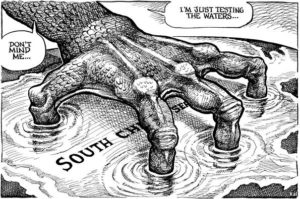COLUMNISTS-OPINION: The Asian Voice: MANILA- A Philippine maritime militia in the sea?: Inquirer columnist
This handout photo courtesy of US Navy shows the aircraft carrier USS Nimitz (CVN 68) and the guided-missile cruiser USS Philippine Sea (CG 58) steam in formation during a Strait of Hormuz transit on September 18, 2020.PHOTO: US NAVY
.
The Asian Voice
A Philippine maritime militia in the sea?: Inquirer columnist
CROSSCURRENTS

The writer says if the Philippine maritime militia vessels will only be small crafts, they can easily be rammed by the steel-hulled Chinese maritime militia vessels

MANILA (PHILIPPINE DAILY INQUIRER/ASIA NEWS NETWORK) – The Philippine Navy recently announced its plan to create a maritime militia that will operate in the West Philippine Sea (WPS).
The primary purpose of the maritime militia will be to conduct low-cost surveillance in our exclusive economic zone (EEZ) in the West Philippine Sea.
The maritime militia will be officially part of the Armed Forces. The Constitution states: “The Armed Force of the Philippines shall be composed of a citizen armed force which shall undergo military training and serve, as may be provided by law.
It shall keep a regular force necessary for the security of the State.” The implementing law of this constitutional provision is Executive Order No. 264 dated July 25, 1987, which President Corazon Aquino issued when she still had legislative powers.
Section 5 of EO 264 provides, “All members of the Citizen Armed Force on training or service shall be subject to military law and the Articles of War.” The maritime militia, who must wear uniforms just like their army counterparts, will be members of the Citizen Armed Force and will form part of the chain of command, with the President as the Commander in Chief.
Under international law, the Philippine maritime militia will be classified as naval auxiliaries of the Philippine Navy.
In case of armed conflict, they will be legitimate military targets whether they are armed or unarmed.
Philippine maritime militia vessels will not qualify as small coastal fishing vessels that are, under international law, immune from attack during armed conflict if they are used exclusively for fishing along the coast.
The activities of the Philippine maritime militia will clearly be military in nature. The maritime militia will operate in Philippine EEZ, beyond Philippine territorial sea.
During peacetime, the Philippine maritime militia must observe the Code for Unplanned Encounters at Sea (CUES) to which the Philippines is a signatory, although the CUES, which applies to naval vessels and auxiliaries, is merely directory and not legally binding.
The maritime militia, however, must mandatorily observe the International Regulations for Preventing Collisions at Sea (COLREGS) issued under the 1972 Convention bearing the same name to which the Philippines is a party.
In sharp contrast, China’s maritime militia operate sub-rosa, disguising themselves as fishermen and their vessels as fishing trawlers.
As proudly described by a Chinese naval officer, “putting on camouflage they qualify as soldiers, taking off camouflage they are law-abiding fishermen.” China’s maritime militia vessels, with reinforced steel hulls, weigh about 500 tons each and are purposely built to ram the fishing boats of other countries.
.
Equipped with water cannons, radar, and with China’s BeiDou satellite navigation system, these ocean-going vessels are owned by the Chinese government.
Chinese maritime militia, who have automatic small arms and rocket-propelled grenades stored in their vessels, receive regular salaries, benefits, and pension from the Chinese government.
China’s maritime militia operate in the EEZs of the Philippines, Vietnam, Malaysia, Brunei, and Indonesia, maritime areas which China is trying to seize from these Asean coastal states.
That is why China’s maritime militia operate covertly, conducting surveillance and other “gray zone” operations.
Occasionally, they ram the fishing boats of other Asean coastal states, intimidating Asean fishermen to abandon their traditional fishing grounds in the South China Sea.
China’s maritime militia are the spearhead of China’s strategy to grab incrementally the EEZs of Asean coastal states without triggering a war.
The Philippine maritime militia, however, will operate only within Philippine EEZ in the WPS, a maritime zone where the Philippines has the legal right to send its vessels to conduct openly law enforcement activities.
If the Philippine maritime militia vessels will only be small crafts or made of wood, they can easily be rammed by the steel-hulled Chinese maritime militia vessels.
.
.
The Philippines might as well send its Coast Guard and Navy to patrol our EEZ in the WPS.
Any armed attack by a Chinese naval vessel on a Philippine Coast Guard or Navy vessel in the WPS will be a clear ground to invoke the US-PH Mutual Defence Treaty, a situation that China is carefully avoiding.
However, a ramming of a Philippine militia vessel by a Chinese militia vessel will raise doubts whether such act is an “armed attack” on a “public vessel” of the Philippines as provided in the treaty.
.
The writer is columnist with the paper. The Philippine Daily Inquirer is a member of The Straits Times media partner Asia News Network, an alliance of 24 news media entities.














